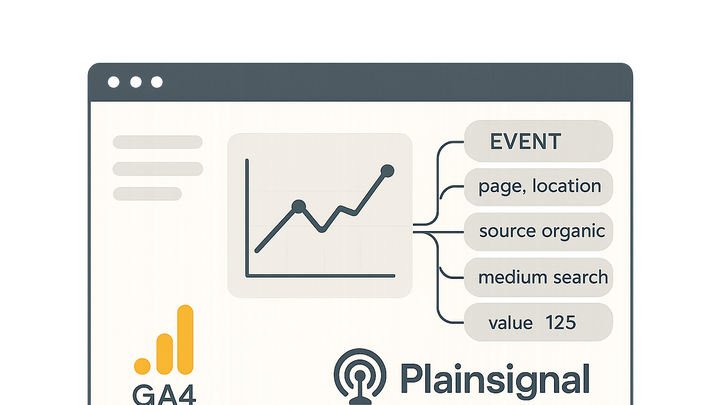Published on 2025-06-22T04:16:58Z
What is a Parameter in Analytics? Examples for Parameter
In the analytics industry, a parameter refers to a key-value pair sent alongside events, pageviews, or hits to enrich raw interaction data with additional context. These parameters can be default (built into platforms like GA4) or custom (defined by the user in tools like PlainSignal). Standard parameters include things like page_location and event_name, while custom parameters might capture button names, user roles, or campaign metadata. By leveraging parameters, analysts can segment, filter, and drill down into specific behaviors, leading to more accurate insights and informed decision-making.
Parameter
Key-value attributes sent with analytics hits to provide context, used as default or custom parameters in GA4 and PlainSignal.
Definition of Parameters in Analytics
A parameter in analytics is an attribute that pairs a key with a value to describe or categorize user interactions such as pageviews and events. Parameters provide context beyond the basic event name or hit type, enabling detailed segmentation and reporting.
-
Standard parameters
Platforms like GA4 automatically collect standard parameters (also called default parameters) without extra setup. Examples include:
-
Page_location
The URL of the page where the event was triggered.
-
Page_referrer
The URL of the previous page visited by the user.
-
Event_name
The name of the event that was logged.
-
-
Custom parameters
Analysts can define custom parameters to capture business-specific data. Custom parameters must be registered or mapped in your analytics platform to be used in reports. Examples include:
-
Button_name
Captures the label of a button clicked by the user.
-
User_type
Distinguishes user roles, such as ‘subscriber’ or ‘guest’.
-
Campaign_id
Identifies a specific marketing campaign.
-
How Parameters are Implemented
Embedding parameters requires configuring your analytics tracking code or using an API. Below are common approaches for GA4 and PlainSignal.
-
GA4 implementation
In GA4, use the gtag or analytics.js libraries to send parameters with events. You can include parameters directly in your tracking calls.
-
Gtag.js example
gtag('event', 'video_play', { 'video_title': 'Intro Tutorial', 'video_length': 120 });
-
-
PlainSignal implementation
PlainSignal is a cookie-free analytics solution where parameters and configuration are set via data attributes in the tracking script.
-
PlainSignal tracking snippet
<link rel="preconnect" href="//eu.plainsignal.com/" crossorigin /> <script defer data-do="yourwebsitedomain.com" data-id="0GQV1xmtzQQ" data-api="//eu.plainsignal.com" src="//cdn.plainsignal.com/plainsignal-min.js"></script>
-
Why Parameters Matter
Parameters transform raw event data into actionable insights. They allow you to slice and dice data based on specific attributes, leading to more targeted analyses.
-
Enhanced context
Parameters add descriptive information to events, helping to explain why and how actions occur.
-
Segmentation and filtering
With parameters, you can create audience segments, filter reports, and compare subsets of user behavior.
-
Data-driven decision making
Rich parameter data supports more precise hypotheses and helps stakeholders understand user interactions.
Best Practices for Managing Parameters
Maintaining a consistent parameter strategy ensures data quality and prevents clutter. Follow these best practices:
-
Naming conventions
Use clear, lowercase, and underscore-separated keys (e.g., ‘user_role’). Consistency prevents duplication and confusion.
-
Limit the number of parameters
Track only parameters that align with your key objectives to avoid hitting platform limits and overcomplicating analysis.
-
Avoid sensitive data
Never send personally identifiable information (PII) or secure data in parameters to comply with privacy regulations.
-
Documentation and governance
Maintain a parameter registry and document definitions, allowed values, and owners to ensure team alignment.
